Your donation will support the student journalists of Rancocas Valley Regional High School. Your contribution will allow us to enter into regional and national competitions, and will help fund trips to journalism conferences to continue to improve our writing and work!
Examining the distribution of race demographics with the new addition of the Accelerated course level
Has the new ACC course level changed classroom demographics in recent years?
March 6, 2023
After the Board of Education approved the Excellence Through Equity Quality Program Review by the Delaware Valley Consortium for Excellence & Equity (DVCEE) on April 27, 2021, the review recommended that the district reconceptualize diversity, which continues to be a topic of discussion regarding the distribution of race demographics across class levels with the addition of the Accelerated (ACC) level.
“Accelerated courses focus on a more rapid, or accelerated, pacing, presuming a mastery of skills which allows for expedited pacing and instruction,” said Director of Curriculum and Instruction Tracy Matozzo. “Skills, such as reading comprehension and the ability to separate information from non-essential information, are already there, which allows for a greater dive into the material.”
The administration continues to refer to the recommendations made by the DVCEE to improve to the culture and environment of RV, and a particular focal point expressed in the review included fostering an “equitable opportunity to learn,” which relates to how students are impacted by the new ACC level and how race demographics have changed since it’s addition.
The opinions regarding the ACC level are widespread with some having positive or negative outlooks, as well as others remaining neutral on the subject. Such varying opinions lead to controversy about the new level and how it benefits students across the board.
“The addition of the ACC level is providing a unique opportunity for a select number of students to achieve a high level of success in a challenging environment,” math teacher Mr. Pinto said. “Before we had the ACC level I think students were faced with the daunting task of deciding between Honors or College Prep [CP] and the vast gap that exists between those levels. ACC students now are able to go into a level that isn’t as rigorous and fast-paced as the Honors track but don’t have to limit themselves or settle for the minimum level available in the CP classes.”
On the other hand, there are mixed feelings about the addition of the ACC level and how it affects students who are at that level as well as those who are in CP or Honors/AP courses.
“Some students were feeling frustrated about the pace of a class and how much content we could get through, so now that I don’t feel like I have to make sure everybody’s with me in terms of the instructions. I do get a sense that those students don’t feel as frustrated anymore [in the ACC level],” English teacher Mrs. Garvey said. “However, when you started pulling out the students who did feel more confident or willing to speak up, it can really suck the life out of the class itself and also take away from students being able to learn from each other in a social way, which is a huge aspect of how students learn, so that has been affected in a CP-level class for sure.”
Although the ACC level does allow students to challenge themselves academically and isn’t as rigorous as the Honors and AP courses, it does raise questions about how CP-level students are affected as well. Some teachers and staff have accused the CP level as becoming a “dumping ground” for lower-level students, which can then contribute to more behavioral issues and distractions from learning.
“It was maybe to the benefit of the higher level kids in pacing, but then to the detriment of the lower level students who really did learn and get something out of being around students who were a little higher in skill level than they were,” Mrs. Garvey said.
However, considering the recommendations made by the DVCEE concerning diversity, some teachers do not see discrepancies in race demographics or how students are performing across class levels.
“I don’t really see any racial issues regarding [class demographic composition] in any of the classes,” history teacher Mr. Freitag, who teaches several different levels of history, said. “Students are performing in general accordance with the group that they’re in. I think that students of various demographics within the levels are doing equal to their colleagues, so I’m not seeing an issue where certain students within a level are underperforming.”
Alternatively, other teachers have observed differences in the racial makeup of different class levels.
“I’ve observed not as much actual diversity, but a fairly decent balance [in Honors and ACC courses], but I would still say that most of those classes have an overall white majority,” Mrs. Garvey said. “I feel like Honors had more different types of ethnicities [whereas] there is still diversity [in CP classes] but it seems more balanced between just predominantly white or Black students.”
This seems to echo some student voices at RV, who are concerned with the stratification of different demographics across the class levels. A number of student anecdotes point to a larger lack of diversity in the more advanced classes. For example, in a class of 25 students enrolled in an English III CP class taught block one last semester, the class included 12 students who identify as Black or African American, seven students who identify as white, four students who identify as a mix of two or more races, one student who identifies as Native Hawaiian or Other Pacific Islander and one student who identifies as Hispanic. If you walk down the hall and visit a block one English III Honors class of 24 students taught during the same period, you would likely see a slightly different demographic composition: 15 students who identify as white, three students who identify as Black or African American, three students who identify as a mix of two or more races and one student who identifies as Asian. While these differences may not be striking, they are noticeable, especially to students who have maintained similar levels throughout their high school years.
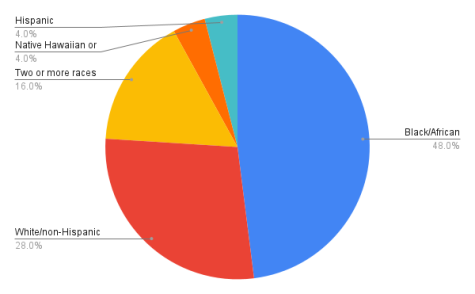
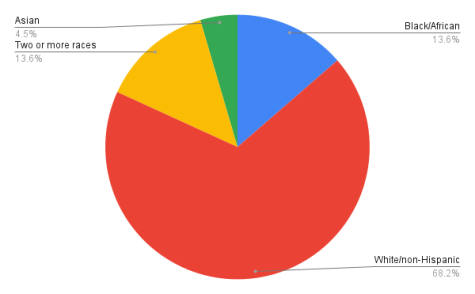
However, other teachers — and students — point to the ACC level as more representative of demographics at RV. In the 2019-2020 academic year, according to the NJ School Performance Report, RV’s demographic makeup consisted of 52.6% of students who identify as white/non-Hispanic, 22.6% of students who identify as Black or African American, 13.9% of students who identify as Hispanic, 6.2% of students who identify as Asian, 4.4% of students who identify as two or more races, 0.2% of students who identify as American Indian or Alaska Native and 0.1% of students who identify as Native Hawaiian or Other Pacific Islander. Some ACC levels seem to better mirror this demographic composition, including an English III ACC block five course and an Algebra I Honors block two course.
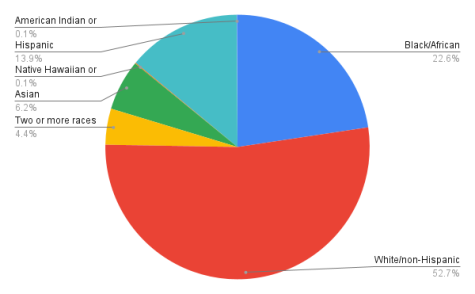
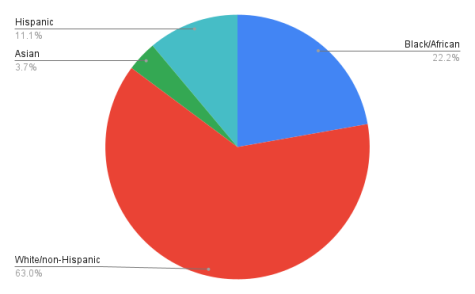
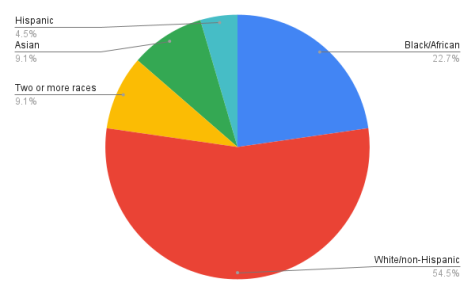
“In my experience, the ACC and Honors levels do have an overall level of diversity that is greater than the CP levels,” Mr. Pinto said. “I have found that the Honors and ACC levels have a larger range of students that belong to all of the racial categories while the CP levels reflect more of the average population dynamics here at Rancocas Valley.”
In 2020, the DVCEE recommend that RV “reevaluate course placement and leveling policies and procedures to encourage more students to access more rigorous academic pathways at RVRHS.” The ACC largely came out of these discussions.
Although the new level has changed the distribution of race demographics in different course levels, the option for an ACC track has only been available for two full school years, so its impact is still not fully concrete since it has not been implemented as long as the CP and Honors tracks.
“It is very tough to say for certain whether or not I have seen a difference in race demographics across the levels prior to the addition of the ACC level,” Mr. Pinto said. “The ACC level was introduced only two years ago. Within that time I have only taught two classes at that level so I think it hasn’t been implemented for a long enough time to make any clear observations in regards to the impact of race demographics.”
Many students seem to find a balance between the rigor of Honors and the ease of CP within the ACC course, which, in the 2022-2023 academic year, has larger class sizes than in years past.
Faculty, administrators and students agree that there is still work to be done in equalizing the playing field and making Honors and AP classes more accessible to all demographics. RV faculty have held professional development sessions in the recent weeks to discuss current AP offerings and ways to encourage students from all backgrounds to enroll in more rigorous courses. The inclusion of newly-created pilot AP programs, like the AP African American Studies course to be taught at RV next year, are largely viewed as positive ways to diversify higher-level courses.
“I’m hopeful that [potential new AP courses like AP African American Studies] can pull a mix of students more largely representative of RV’s demographics as a whole,” said English teacher Mrs. Sherman, who teaches both English III Honors and ACC classes. “It’s not just about making the course more accessible, it’s about making the concept of AP and Honors classes, the rigor of these, more attractive to students from all backgrounds.”